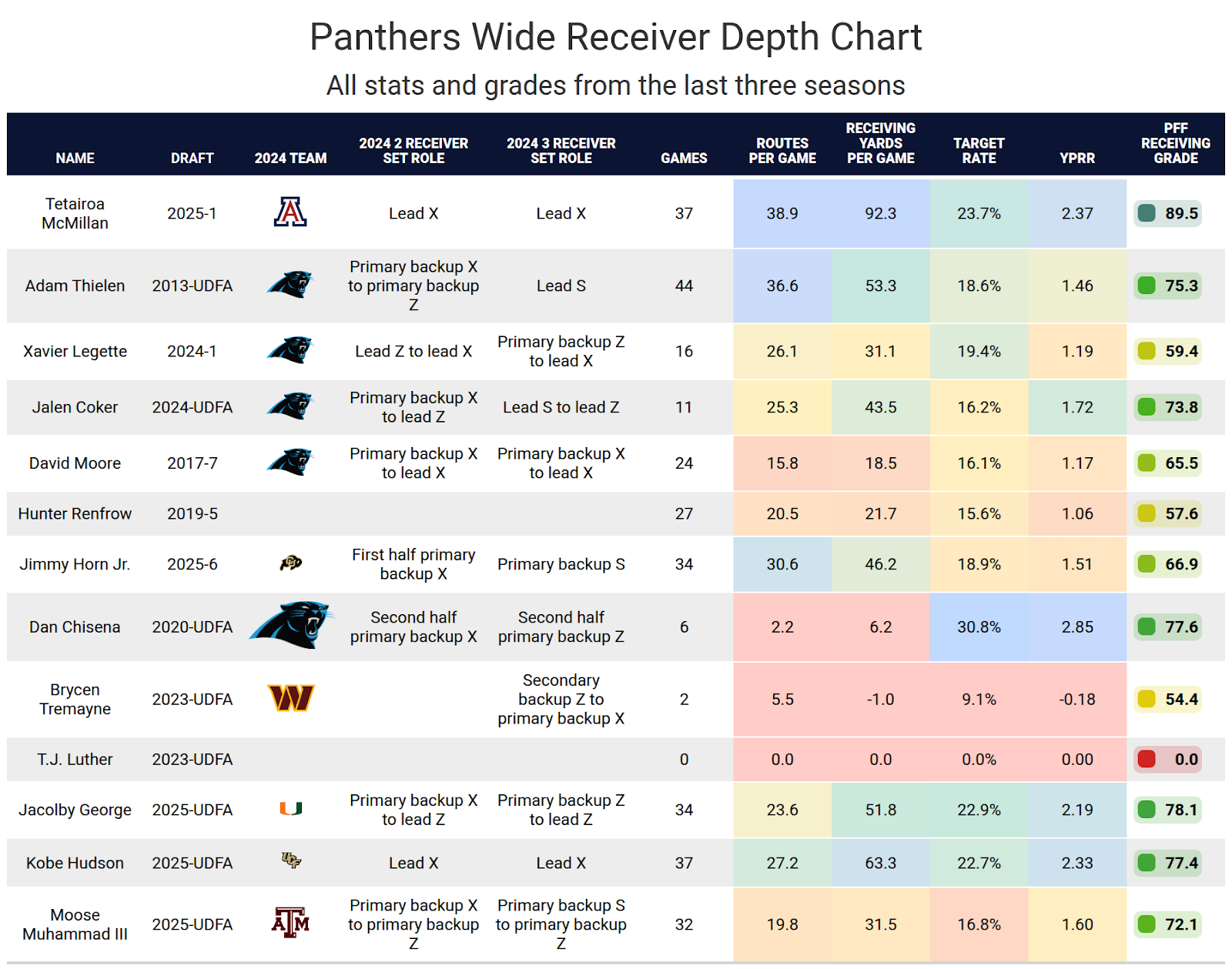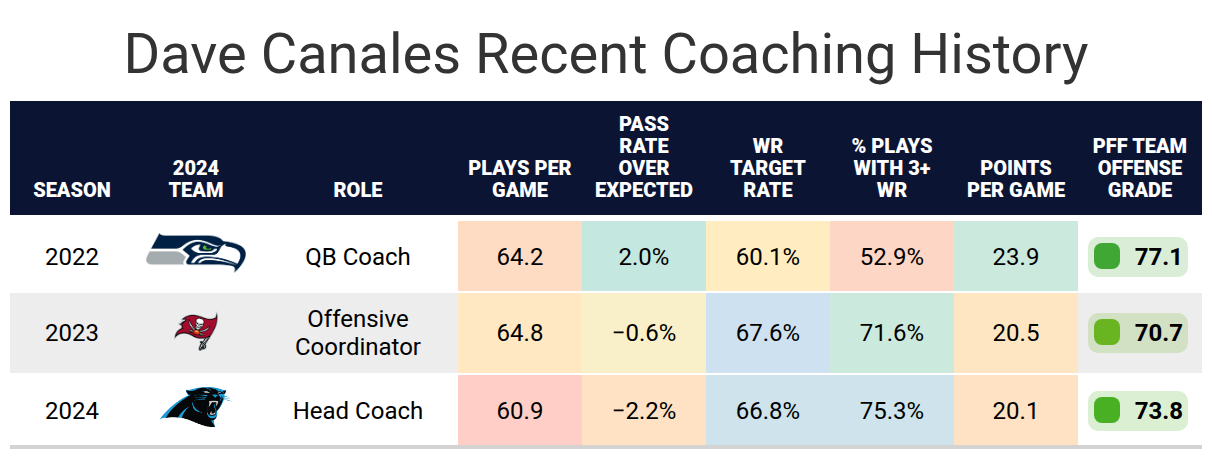
- Rookie year had ups and downs: Xavier Legette‘s first season with the Carolina Panthers was inconsistent, highlighted by a strong Week 4 performance but otherwise lacking in consistent fantasy production.
- Legette looking for a leap: While the Panthers drafted Tetairoa McMillan with their first-round pick, there is still room for Legette to become a fantasy starter if he improves his quality of play.
- Subscribe to PFF+: Get access to player grades, PFF Premium Stats, fantasy football rankings, all of the PFF fantasy draft research tools and more!
Estimated Reading Time: 5 minutes

PFF’s Fantasy Football Player Profile series delivers the most in-depth fantasy football analysis available for the 2025 season.
Using PFF’s exclusive data, we evaluate player performance, competition for touches and how teammates and coaching staffs
Last updated: 7:15 a.m. Saturday, June 21
Player performance
Xavier Legette was the 32nd overall pick of the 2024 NFL Draft by the Carolina Panthers. The 2023 team had D.J. Chark Jr., Jonathan Mingo and Terrace Marshall Jr. as their top outside receivers. Chark and Marshall weren’t on the team in 2024, and Mingo was traded midseason.
Legette was eased into the offense, playing less than 60% of Carolina’s offensive snaps in four of his first five games. Diontae Johnson was the top outside receiver, and Mingo was still playing significant snaps. Legette had a standout game in Week 4 against the Cincinnati Bengals, catching six passes for 66 yards and a touchdown.
By Week 6, Legette was clearly ahead of Mingo. Johnson played his last game with the Panthers in Week 7, and Mingo played his last game in Week 9. Legette’s fantasy value seemed to be on the rise, finishing with three more touchdowns from Weeks 6-9. His playing time skyrocketed to over 87% in each game from Weeks 10-14, but that didn’t lead to an increase in value, only catching three to four passes each week.
Legette suffered a groin injury in Week 15, causing him to miss Week 16. He played the last two weeks of the season, but his playing time was notably limited. His Week 4 game was the peak of his fantasy season. He never exceeded 10 PPR points from receptions and yards alone in any other game. His only weeks as a top-36 fantasy wide receiver were the weeks he scored touchdowns.
He struggled to get open, and it probably didn’t help that he was the top outside wide receiver on the team. While there wasn’t much that stood out from a statistical perspective, Legette reportedly looks like a different player this offseason.


Projected role
The Panthers made an interesting move in the middle of the season in how they used Legette. He started the season as the Z receiver, while Johnson was at X and Thielen was in the slot. When Thielen was injured, Jalen Coker took over as the slot receiver. Once Johnson was traded, David Moore took over at X. However, Coker was playing well enough that the Panthers wanted both Coker and Thielen in the lineup when Thielen was healthy. The Panthers, therefore, moved Legette to the X receiver and Coker to the Z so that Thielen could remain in the slot.
Legette played noticeably better when lined up off the line, like a Z receiver, compared to on the line like an X. He had a 57.3 PFF receiving grade with 0.96 yards per route on the line compared to a 64.3 grade and 1.48 yards per route off the line.
The big change for the Panthers’ wide receiver room was the Tetairoa McMillan addition. The good news is that McMillan is a clear X receiver, so Legette won’t need to frequently play there like he did in the second half of last season. The problem is that Jalen Coker will be competing with Legette for playing time, and Coker played better than Legette on a per-play basis last season. Coker played better in the slot, but Coker would be competing with Thielen and Renfrow for those slot snaps, so his cleanest route to snaps is in the slot. Even David Moore outplayed Legette on a per-play basis, and Moore played some Z receiver last season once Legette moved to X.
While the depth chart may seem worrisome, the scenario for Legette is simple. The only way he has fantasy value this season is if he makes notable strides in his second season. If he makes those strides, he will be the clear starter over Coker. If he can’t make those strides, it doesn’t matter how much playing time he has – he won’t be fantasy-relevant.


Impact of teammates
Legette will be in Dave Canales’ offense, catching passes from Bryce Young for a second-straight season. Canales’ two seasons leading an offense have been slightly run-heavy, finishing with high rates of throwing to wide receivers. The bad news is that a lot of his success has been with X receivers, which is better news for McMillan.
Young made notable strides during the second half of last season, but that didn’t impact Legette’s fantasy value. Young has a high rate of throwing to his first read. That wasn’t Legette very often last season. This is again a case where, if Legette makes notable strides, he will be thrown to more often.


Bottom line
Xavier Legette had a relatively disappointing rookie season. Everything from the quarterback to a path to significant playing time and targets is there if Legette makes enough strides as a player. If he doesn’t, Legette won’t need to be on fantasy rosters.

Footnotes
- Statistics in tables and charts were chosen based on their ability to predict future fantasy performance on a per-game or per-opportunity basis or to describe the player relative to others at the same position.
- “Opportunities” are defined as passing dropbacks, rushing attempts and routes run as a receiver.
- Numbers are provided either by season or based on the past three years. For rookies, only college statistics are included. For non-rookies, only NFL statistics are considered, regardless of whether they played in college within the previous three years.
- As college competition is easier than NFL competition, most rookies are likely to see a decline from their historical numbers.
- Only FBS data is considered for college players and comparisons.
- Kneel-downs are removed from rushing data to provide cleaner quarterback rushing rate statistics.
- The table colors in this article range from blue (indicating good/high) to red (indicating bad/low).
- All percentiles and color codings compare the given player to others with a high sample of opportunities. Generally, the cutoff is one-third of the possible opportunities in the sample. If a player does not meet the threshold, they are still included in the comparison, though their results may appear better or worse than expected due to the smaller, less predictive sample size.
- Information on utilization classifications and their importance can be found here for running backs, wide receivers and tight ends.
This news was originally published on this post .






Be the first to leave a comment